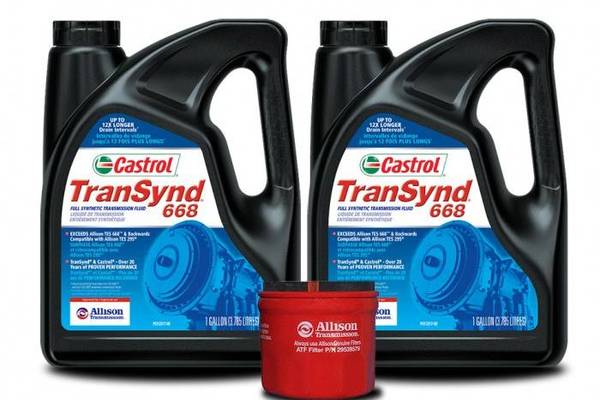
Allison 3000 Transmission Fluid Capacity (Oil Type and Tips)
The Allison 3000 may have to re-learn shift points after a fluid change. It is a quirk but the gearing seems to have a forgetful memory when new fluid is put into the pan. This quirk will give you some temporary hard jolts at first.
The amount of transmission fluid you will need to fill up the fluid tank depends on the size of the pan. A standard pan takes 17 quarts while the 2-inch deeper pan should only take 19 quarts.
To learn more about this important topic, just continue to read our article. Its content provides you with important information when your RV is equipped with an Allison 3000 transmission. Take a few minutes to get up to speed on this topic.
How Many Quarts Of Transmission Fluid Does An Allison 3000 Take?

There are two fluid levels when it comes to Allison 3000 transmissions. The standard or regular pan should only hold 17 quarts. While the deeper pan should only hold 19 quarts.
There will be occasions where you may have to put more fluid inside this transmission. That situation usually arises when your RV, etc., has been sitting for a while.
In this case, you may see an additional 2 or 3 quarts put inside the pan. The explanation for this situation is that since the transmission has been sitting idle, more of the old fluid drained down into the pan.
That may be so or it may not be so but those words come straight from Allison. If true, then it may be a good thing as you are getting more of the old fluid out of the mechanism and more new fluid inside.
Also, check the year your transmission was built. That may have some influence on how much fluid you put inside this transmission.
Allison 3000 Transmission Fluid Capacity

The capacity has not changed in the last few sentences. You should get 17 and 19 quarts inside the transmission depending on the fluid pan used for your particular model.
If you want that capacity in liters, then you are looking at 28 liters for the deeper pan and 25 for the shallower or regular pan. It all sounds like a lot but RV transmissions are not the same as car or truck transmissions.
What you should be concerned about is the amount of fluid loss that happens when you change the filter. The main filter may be the source of a 2-quart fluid loss while the lube filter may be responsible for up to 8 quarts of lost fluid (1.9 & 7.6 liters respectively).
The key to keeping your transmission running at top levels is to make sure to make those fluid changes regularly and on schedule. Deviating from the schedule may not initially harm the transmission but eventually, it may harm it.
Keep it on schedule so that your transmission does not wear out sooner than you want it to.
Allison 3000 Transmission Fluid Type

The company seems to have two sets of approved fluids for you to use. Those two sets will be briefly mentioned below:
Allison has developed, or someone has, a synthetic fluid that is perfect for their transmissions. It is called TES 668. This fluid option is the next generation and the upgrade over the TES 295 version that has been used by Allison successfully for 20 years.
Plus, it is the approved synthetic fluid for all of its transmission series between 1000 and 4000.
This option you should not have to worry about. The synthetic fluid is designed for the big rigs that haul more tons of dirt, etc than a tank weighs. The TES 439 option is for all Allison transmission series from 5000 to 9000.
The TES 439 is the upgrade over the TES 353. What we find interesting in both categories is that the brand name does not matter. You can use any brand that makes and sells the TES 668.
On both web pages linked above, there is a lit of recommended brands you should be using. For the on-highway driving, you have about 20 brands to choose from.
How Often Should You Change The Allison 3000 Transmission Fluid?

This will depend on the type of fluid you are running in your transmission. The latest figures we could find stop at the TES 295 and 389. We have not found any specs for the new TES 668 fluid.
Under general conditions, the TES 295 needs to be changed every 48 months or 300,000 miles while the 389 option says 25,000 miles and 12 months. If you want it in hours, that is every 6,000 and 1,000 hours respectively.
Under severe conditions, the TES 295 needs to be changed every 48 months or 150,000 miles & 6,000 hours. The TES 389 requirements under the same condition are 12,000 miles, 6 months, or 500 hours.
The filters should be changed sooner than those figures with a respective 75,000 and 25,000 miles under general conditions. Under severe you are looking at needing a change at 75,000 and 12,000 miles.
Or 3 & 1 year and 3 years and 6 months. It is best to check and keep to the schedule so you do not drive with a worn-out filter and risk damaging the transmission.
Some Final Words
Taking care of your transmission is essential if you do not want to have major overhaul expenses a few years down the road. Good maintenance habits help prevent costly repairs and they do not take up a lot of time.
Make sure to use the right fluid in your transmission as these modern pieces of equipment are more finely tuned than older cars and trucks’ transmissions. Take the time to do some research to make sure you know how to properly maintain this piece of vital equipment.

